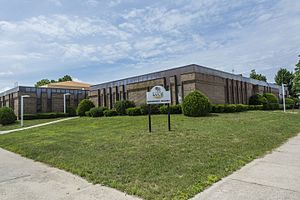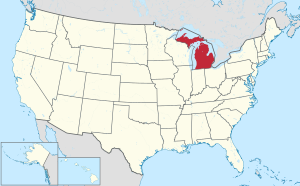|
Luce County, Michigan
Luce County (/luːs/ LOOS) is a county located in the Upper Peninsula in the U.S. state of Michigan. As of the 2020 census, the population was 5,339,[2] making it the second-least populous county in Michigan (behind Keweenaw County). The county seat is Newberry, Luce County's only incorporated community.[3] The county was set off and organized in 1887 and named after former Michigan Governor Cyrus G. Luce.[1] In 2002, Newberry was designated as the moose capital of Michigan by the state legislature.[4] Luce County is served by The Newberry News, a weekly community newspaper that began in 1886. GeographyAccording to the U.S. Census Bureau, the county has a total area of 1,912 sq mi (4,950 km2), of which 899 sq mi (2,330 km2) is land and 1,013 sq mi (2,620 km2) (53%) is water.[5] Luce County is part of the Upper Peninsula of Michigan. It has a northern border with Canada across Lake Superior. McMillan Township, the largest municipality in Michigan by land area (at 588.78 square miles (1,524.9 km2) of total land area), is part of Luce County. Major highways
AirportLuce County Airport (KERY), provides service for the county and surrounding communities. Adjacent counties
CommunitiesVillage
Civil townshipsUnincorporated communitiesIndian reservations
Demographics
The 2010 census indicated Luce County had a population of 6,631.[11] This is a decrease of 393 people from the 2000 United States census. This is a -5.6% change in population. In 2010 there were 2,412 households and 1,542 families residing in the county. The population density was 7 people per square mile (2.7 people/km2). There were 4,343 housing units at an average density of 5 per square mile (1.9/km2). In 2020, its population was 5,339.[2] At the 2010 census, the racial makeup of the county was 80.4% White, 11.1% Black or African American, 5.0% Native American, 0.3% Asian and 3.1% of two or more races; of them, 1.2% were Hispanic or Latino (of any race). In 2010 among its population, 14.5% were of German, 7.6% French, French Canadian or Cajun, 7.4% Irish, 6.8% English, 6.3% American and 5.5% Finnish ancestry.[12] At the 2022 American Community Survey, its racial makeup was 87.6% non-Hispanic white, 1% Black or African American, 6.9% Native American, 0.2% Asian American, 0.1% Pacific Islander, 4.2% multiracial, and 2% Hispanic or Latino of any race.[2] There were 2,412 households, out of which 24.3% had children under the age of 18 living with them, 50.2% were married couples living together, 9.3% had a female householder with no husband present, and 36.1% were non-families. 31.4% of all households were made up of individuals, and 13.8% had someone living alone who was 65 years of age or older. The average household size was 2.25 and the average family size was 2.77. In the county, the population was spread out, with 17.9% under the age of 18, 7.0% from 18 to 24, 27.5% from 25 to 44, 29.6% from 45 to 64, and 17.9% who were 65 years of age or older. The median age was 43 years. The population was 57.7% male and 42.3% female. In 2010, the median income for a household in the county was $42,083, and the median income for a family was $49,948. The per capita income for the county was $18,294. About 12.6% of families and 16.3% of the population were below the poverty line, including 27.7% of those under age 18 and 12.5% of those age 65 or over. From 2017–2021, its median household income was $49,667.[2] Religiously, the Association of Religion Data Archives in 2020 determined Christianity was the dominant religion. Roman Catholicism and the Evangelical Lutheran Church in America were the largest Christian groups in the county.[13] Government
The county government operates the jail, maintains rural roads, operates the major local courts, keeps files of deeds and mortgages, maintains vital records, administers public health regulations, and participates with the state in the provision of welfare and other social services. The county board of commissioners controls the budget but has only limited authority to make laws or ordinances. In Michigan, most local government functions — police and fire, building and zoning, tax assessment, street maintenance, etc. — are the responsibility of individual cities and townships. Elected officials
(information as of March 2024)[15] See also
References
Bibliography
External links |
||||||||||||||||||||||||||||||||||||||||||||||||||||||||||||||||||||||||||||||||||||||||||||||||||||||||||||||||||||||||||||||||||||||||||||||||||||||||||||||||||||||||||||||||||||||||||||||||||||||||||||||||||||||||||||||||||||||||||||||||||||||||||||||||||||||||||||||||||||||||||||||||||||||||||||||||||||||||||||||||||||||||||||||||||||||||||||||||||||||||||||||||||||




